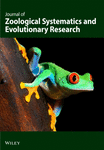Evolution of the nauplius stage in malacostracan crustaceans*
Presented at the Phylogenetic Symposium in Vienna/Austria from 19th to 21st November 1999.
Abstract
This article gives an overview on some aspects of malacostracan development at the levels of gene expression, cell division, and shape of embryos and larvae. The various modes of development found in malacostracans are discussed in a phylogenetic and an evolutionary framework. It is suggested that the plesiomorphic condition within the Malacostraca is an embryonized egg-nauplius which is characterised by a yolky egg, precocious development of the three anteriormost head segments, an antero-ventrally folded caudal papilla, and a growth zone formed by rings of 19 ecto- and eight mesoteloblasts. Several alterations of this malacostracan ground pattern occurred concerning the arrangement and the number of teloblasts, the shape of the embryo and the timing of segmentation with respect to the naupliar segments. From their distribution within the phylogenetic tree and from their larval characteristics it is concluded that the free-living nauplius larvae of euphausiids and dendrobranchiate decapods are secondarily evolved from ontogenies without a free-living nauplius. Because the nauplius stage is lost in several malacostracan taxa, the concept of the nauplius as a phylotypic stage of crustaceans is refuted. In addition, the nauplius as an example of the recapitulation of ancestral characters is discussed.




